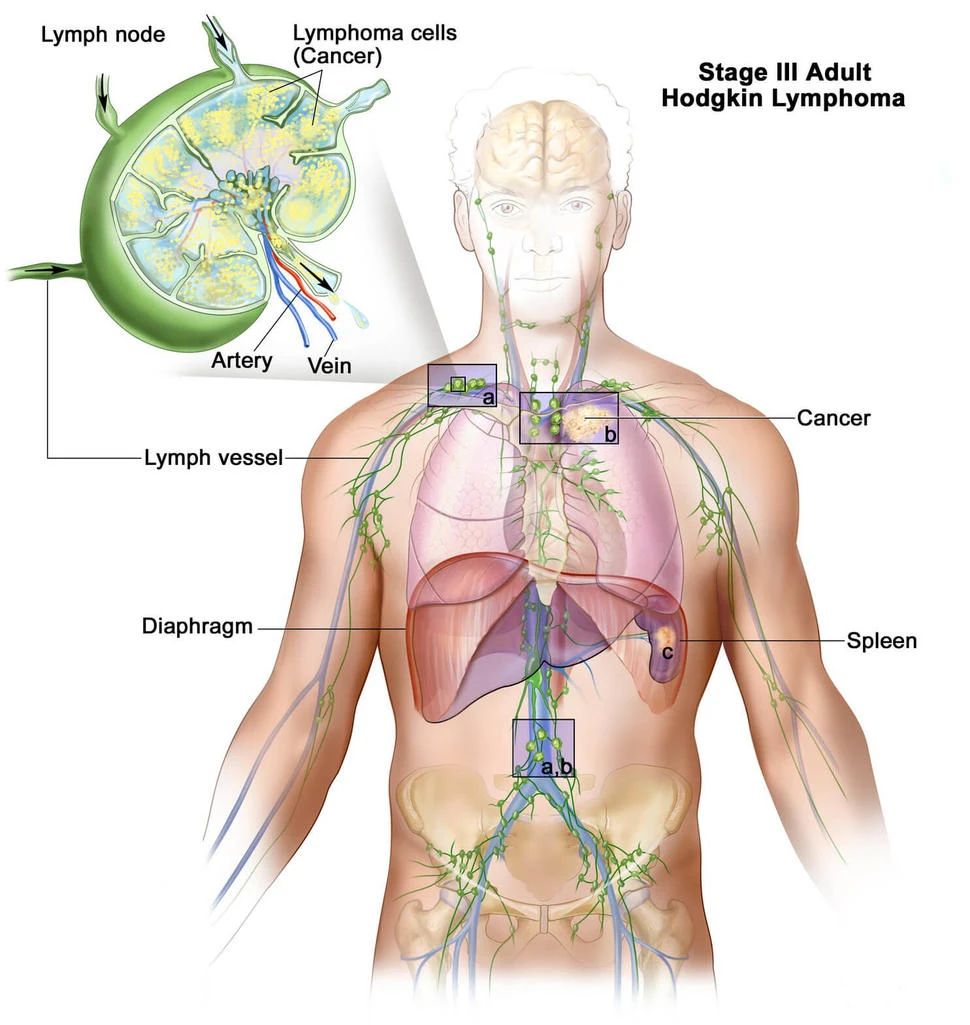1. What is Hodgkin Lymphoma?
Hodgkin Lymphoma (HL), also known as Hodgkin’s disease, is a type of cancer that originates in the lymphatic system, which is part of the body’s immune system. It is characterized by the presence of abnormal cells called Reed-Sternberg cells. Hodgkin Lymphoma is less common than Non-Hodgkin Lymphoma and tends to have a distinct pattern and treatment approach.
2. Types of Hodgkin Lymphoma
Hodgkin Lymphoma is primarily categorized into two main types:
Classical Hodgkin Lymphoma (cHL): The most common form, characterized by the presence of Reed-Sternberg cells. It is further divided into four subtypes:
- Nodular Sclerosing Hodgkin Lymphoma: Often found in young adults, it features tumors with fibrous tissue and typically affects lymph nodes in the chest or neck.
- Mixed Cellularity Hodgkin Lymphoma: Contains a mix of Reed-Sternberg cells and other immune cells, often found in the lymph nodes, spleen, and bone marrow.
- Lymphocyte-Rich Hodgkin Lymphoma: Characterized by a predominance of normal lymphocytes alongside Reed-Sternberg cells. It is less common and usually affects lymph nodes.
- Lymphocyte-Depleted Hodgkin Lymphoma: The rarest subtype, with Reed-Sternberg cells in a background of very few lymphocytes. It can be more aggressive and typically affects older adults.
Nodular Lymphocyte-Predominant Hodgkin Lymphoma (NLPHL): A less common type where Reed-Sternberg cells are replaced by lymphocyte-predominant cells. It tends to have a slower progression and a better prognosis compared to classical Hodgkin Lymphoma.
3. Symptoms of Hodgkin Lymphoma
Symptoms can vary based on the stage and location of the disease but commonly include:
- Swollen Lymph Nodes: Painless lumps in the neck, armpits, or groin.
- Unexplained Weight Loss: Significant loss of weight without a known cause.
- Persistent Fever: Unexplained fevers that persist over time.
- Night Sweats: Severe sweating during the night that soaks clothing and bedding.
- Fatigue: Persistent tiredness or weakness not relieved by rest.
- Itching: Itchy skin, which may not be specific to the area of lymph node involvement.
- Abdominal Pain or Swelling: If lymph nodes in the abdomen are affected, it can cause discomfort or swelling.
4. Diagnosis of Hodgkin Lymphoma
The diagnostic process typically involves:
- Medical History and Physical Exam: Evaluation of symptoms and physical examination of swollen lymph nodes.
- Biopsy: The primary method for diagnosing Hodgkin Lymphoma. A sample of lymph node tissue is removed and examined under a microscope for Reed-Sternberg cells.
- Imaging Tests: CT scans, PET scans, or MRIs are used to determine the extent of the disease and locate affected lymph nodes.
- Bone Marrow Biopsy: Sometimes performed to check if the cancer has spread to the bone marrow.
5. Treatment Options for Hodgkin Lymphoma
Treatment for Hodgkin Lymphoma is tailored to the type, stage, and individual patient factors. Common treatments include:
- Chemotherapy: Uses drugs to kill or inhibit the growth of cancer cells. It is often the primary treatment for Hodgkin Lymphoma and may be combined with other treatments.
- Radiation Therapy: Targets cancer cells in specific areas with high-energy rays. It is frequently used in conjunction with chemotherapy, particularly for localized disease.
- Immunotherapy: Uses drugs to help the immune system recognize and attack cancer cells. It may be used in cases where other treatments are not effective.
- Stem Cell Transplant: Replaces damaged bone marrow with healthy stem cells. This may be an option if the disease does not respond to initial treatments or relapses.
- Targeted Therapy: Focuses on specific molecules involved in cancer growth. It may be used in certain cases or as part of clinical trials.
6. Support and Coping
Managing Hodgkin Lymphoma involves addressing both physical and emotional aspects:
- Medical Team: Work closely with oncologists, hematologists, radiologists, and other specialists to develop and follow a treatment plan.
- Support Groups: Connect with others affected by Hodgkin Lymphoma for emotional support and practical advice.
- Counseling and Therapy: Professional counseling can help manage the emotional and psychological impact of the disease and treatment.
- Lifestyle Adjustments: Maintain a healthy diet, follow exercise recommendations, and engage in activities that promote overall well-being.
7. Research and Advances
Ongoing research is continuously improving the understanding and treatment of Hodgkin Lymphoma. Clinical trials provide opportunities to access new therapies and contribute to advancements in care. Staying informed about the latest developments can offer hope and new treatment options.
8. Conclusion
Hodgkin Lymphoma is a distinct type of lymphoma with specific characteristics and treatment approaches. Early detection, personalized treatment plans, and a strong support system are key to effectively managing the condition. If you or someone you know is facing Hodgkin Lymphoma, work closely with healthcare professionals to navigate the journey and explore available resources for support and care.

